Death Penalty

THERE IS A nationwide trend of Republican state lawmakers rethinking the death penalty, and their faith is playing a central role. From Catholics to evangelicals, Christian lawmakers on the Right are abandoning capital punishment like never before.
Take Colorado as an example. For years a bill to repeal the death penalty ran into a wall in the state Senate. This year three Republican senators co-sponsored the bill and provided the crucial votes for it to pass. The Colorado House of Representatives approved it and the governor signed it into law in March—making Colorado the 22nd state to abolish the death penalty.
Why did they do it? These Republican lawmakers decided the death penalty does not align with their Christian or conservative values: the sanctity of human life, individual liberty, and limited government. They see a system that exonerates one person on death row for every nine it executes, with more than 160 people in the U.S. being freed from death row due to wrongful convictions since 1973. They see a bloated government program that does nothing to make people safer.
“We were created in the image of God and that is a very good thing. And part of what that means, in my understanding, is it is against the natural order for one created in the image of God to willfully take the life of another created in the image of God,” said state Sen. Owen Hill. “My conscience demands that I vote to abolish the death penalty in Colorado.”
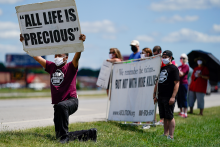
On July 14 the federal government executed Daniel Lewis Lee — the first federal execution in 17 years.


Patrick Murphy's execution was again halted Thursday because Texas death row inmates' final access to spiritual advisors of their faith differs for Christians and Buddhists. Murphy, a 58-year-old Buddhist, is one of two surviving members of the infamous "Texas Seven," a group of escaped prisoners who committed multiple robberies and killed a police officer near Dallas in 2000 during more than a month on the run. Four others have already been executed, one killed himself when police caught up to them in Colorado, and one other remains on death row with Murphy.

Each of the 62 men in the federal prison in Terre Haute, Ind., are quite likely guilty of horrible crimes, and those crimes should have consequences. To be anti-death-penalty is not to be anti-victim or anti-justice. To be anti-death penalty is simply to insist that we can deal with violent crime without mirroring the violence and taking another life.
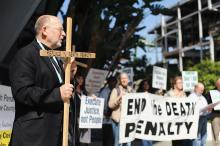
The U.S. Justice Department on Thursday reinstated a two-decades long dormant policy allowing the federal government's use of capital punishment and immediately scheduled the executions for five death row federal inmates.
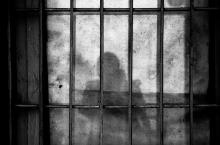
We weren’t meant to kill people. When we do kill, it does something to us. In writing my book Executing Grace, I interviewed a former executioner who told me how he was haunted by the spirits of the men he executed, whose souls visited him at night and sat by his bedside.
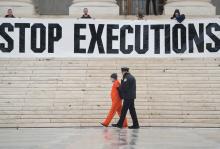
ON MARCH 13, California Gov. Gavin Newsom signed an order issuing a moratorium on the state’s death penalty—providing a reprieve from execution for 737 people on death row. Newsom cited as reasons that the ultimate penalty provides no public safety benefit and has no value as a deterrent. As someone who has worked as a public defender inside the criminal justice system for 30 years, I applaud the humanity and compassion of his decision.
While the number of countries that employ the death penalty dwindles, the United States and several others still enforce it. Despite strong empirical evidence to the contrary, we are led to believe capital punishment is reserved for the “worst of the worst” and that it is supported by victims and law enforcement alike. Leaving aside that 156 people on death row nationwide have been exonerated since 1973, the death penalty is discriminatory in its application and in the selection of those whom the state seeks to kill. It is largely sought because of the economic status of the defendant, the race of the victim and the defendant, and where the crime took place, not because of the circumstances of the offense.

California Gov. Gavin Newsom will impose a moratorium on the state's death penalty on Wednesday, granting reprieves to all 737 inmates on death row and closing the state's execution chamber, an administration source said.

The Roman Catholic Church formally changed its teaching on Thursday to declare the death penalty inadmissible whatever the circumstance, a move that is likely to be viewed askance in countries where capital punishment is legal.

What must it be like to survive your own execution?
It happened this week in Ohio. And it’s not the first time.

With these words the pope is also reshaping what it means to be “pro-life.” He is moving it away from primarily opposing abortion and stressing that it means protecting life at every stage, from womb to natural death.

While there still have been no executions in California since 2006 — largely due to a court battle over lethal injection drug protocols — that could change if the state’s proposed single-drug method for lethal injection passes legal muster. More than 15 of the state’s death row inmates have exhausted all of their appeals, so if it does, prosecutors undoubtedly will be asking judges to set immediate execution dates.

More than 50 years later, California still lists lethal gas as a legal execution means. So do five other states: Arizona, Mississippi, Missouri, Oklahoma, and Wyoming, although Mississippi and Oklahoma, which use nitrogen hypoxia, don’t use that term. (More on that below). I learned this as I searched on my phone standing in front of John Singer Sargent’s monumental 1919 painting “Gassed,” which is on display in the New-York Historical Society’s exhibition “World War I Beyond the Trenches” (through Sept. 3).
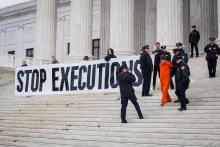
When will the killing end? Why does the government, 31 states and the U.S. Supreme Court, sanction the killing of people who kill to show that killing is wrong? Some 140 countries, including the European Union, and 19 states in the U.S., no longer practice the death penalty. On Jan. 17, 2017, we, 12, along with many others, went to the Supreme Court, the highest Court in the land, to call on the Court and the nation to stop executions.

“The Church has both the unique ability and unparalleled capacity to confront the staggering crisis of crime and incarceration in America,” the declaration reads, “and to respond with restorative solutions for communities, victims, and individuals responsible for crime.”

On June 9, the U.S. Department of Justice indicted Adam Purinton, a white man from Kansas, with hate charges for allegedly shooting three men. Two of the men were Indian nationals, and one died of his wounds. According to the Kansas City Star, Srinivas Kuchibhotla, the Indian national who was fatally shot, worked at the company Garmin’s Olathe, Kansas location as an engineer, alongside fellow engineer Alok Madasani, the second Indian national who was shot.
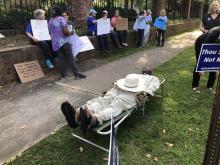
Griffen is still flummoxed how a ruling on a routine property case coupled with participation in his church’s Good Friday prayer vigil put him in the eye of a political storm — one that may now cost him his job. But he suspects the issue goes deeper than whether or not he impartially followed the law.

You might think these men were sentenced to death and slated for execution simply because of the gravity of their crimes. You’d be wrong.
There is something beyond the terrible crimes that determined their fates even more so: poverty. The death penalty preys on poor and vulnerable populations.

“Many of the findings of the commission’s year-long investigation were disturbing, and led commission members to question whether the death penalty can be administered in a way that ensures no innocent person is put to death,” according to the in-depth report.